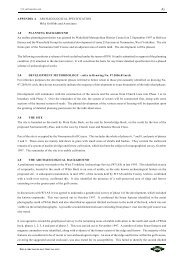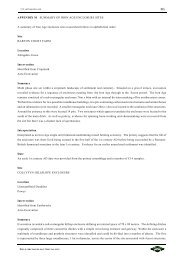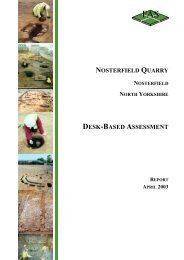ARCHAEOLOGICAL EVALUATION - Mike Griffiths and Associates
ARCHAEOLOGICAL EVALUATION - Mike Griffiths and Associates
ARCHAEOLOGICAL EVALUATION - Mike Griffiths and Associates
Create successful ePaper yourself
Turn your PDF publications into a flip-book with our unique Google optimized e-Paper software.
FAS_lbf01.wpd 156<br />
consisting of an orangish-brown gravel <strong>and</strong> clayey silt with<br />
b<strong>and</strong>s of more grey gravel running throughout. The surface of<br />
C1124 reflected ground level topography.<br />
Two features were defined within Intervention 38 <strong>and</strong> were<br />
allocated F49 <strong>and</strong> F55 (Figure 100). F49 first appeared as a<br />
small sub-circular deposit of brown s<strong>and</strong>y silt. It measured<br />
c.0.30m in diameter <strong>and</strong> was initially half-sectioned NW-SE<br />
where it proved to be a shallow gently sloping cut no greater<br />
than 0.07m deep (Figure 101). The pit had been backfilled<br />
once with C1247, a firm brown s<strong>and</strong>y silt which contained<br />
charcoal flecks. F49 was interpreted as a possible truncated<br />
pit.<br />
Plate 46 Intervention 38 looking east (scale<br />
2m)<br />
F55 was identified as a modern field drain orientated NNW-SSE <strong>and</strong> visible for the width of Intervention 38.<br />
8.2.33 Intervention 39<br />
Intervention 39 was situated in the northeastern corner of Zone<br />
A <strong>and</strong> measured 50m x 4m (see Figure 36). The trench was<br />
machine-excavated <strong>and</strong> was orientated east-west (Plate 47).<br />
The local ground surface sloped down from c.40.00m AOD at<br />
the western end of the trench to c.39.60m AOD at the eastern<br />
end. The dark yellowish-brown ploughsoil was found to be<br />
0.30-0.40m in depth throughout the trench <strong>and</strong> overlay a welldrained<br />
homogenous orangish-brown gravel <strong>and</strong> clayey silt<br />
subsoil (C1124). The surface of C1124 reflected the local<br />
topography.<br />
Plate 47 Intervention 39 looking west (scale<br />
2m)<br />
A single feature was identified within Intervention 39 <strong>and</strong> allocated F52 (Figure 102). F52 was defined initially<br />
as a small circular deposit of dark greyish-brown s<strong>and</strong>y silt. The deposit measured 0.22m in diameter <strong>and</strong> upon<br />
excavation proved to be a shallow irregular feature, measuring 0.13m deep (Figure 103). A single backfill was<br />
identified <strong>and</strong> allocated C1250, which was a firm dark greyish-brown s<strong>and</strong>y silt containing rare fine gravel,<br />
pebbles <strong>and</strong> a few charcoal flecks. F52 was interpreted as a<br />
possible truncated pit.<br />
8.2.34 Intervention 40<br />
Intervention 40 was situated 108.0m from the northern<br />
boundary of Zone A <strong>and</strong> 90.50m west of Intervention 39 (see<br />
Figure 36). The trench was machine excavated, measured 50m<br />
x 4m <strong>and</strong> was orientated east-west (Plate 48). The surrounding<br />
ground surface sloped down gently from the eastern end at<br />
Plate 48 Intervention 40 looking east (scale<br />
2m)<br />
FIELD ARCHAEOLOGY SPECIALISTS







